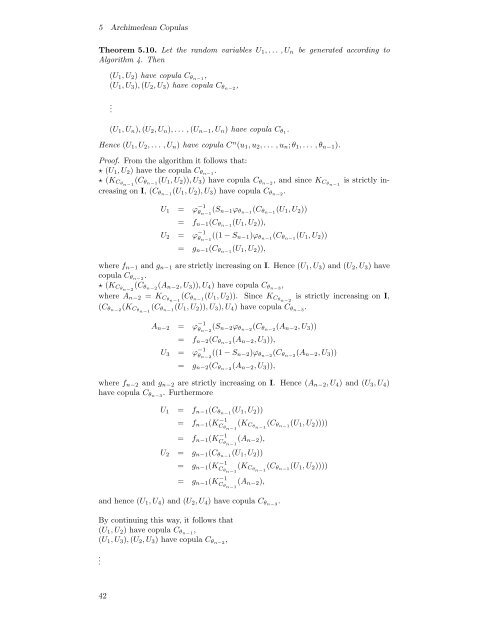Modelling Dependence with Copulas - IFOR
Modelling Dependence with Copulas - IFOR
Modelling Dependence with Copulas - IFOR
You also want an ePaper? Increase the reach of your titles
YUMPU automatically turns print PDFs into web optimized ePapers that Google loves.
5 Archimedean <strong>Copulas</strong><br />
Theorem 5.10. Let the random variables U 1 ,... ,U n<br />
Algorithm 4. Then<br />
be generated according to<br />
(U 1 ,U 2 ) have copula C θn−1 ,<br />
(U 1 ,U 3 ), (U 2 ,U 3 ) have copula C θn−2 ,<br />
.<br />
(U 1 ,U n ), (U 2 ,U n ),... ,(U n−1 ,U n ) have copula C θ1 .<br />
Hence (U 1 ,U 2 ,... ,U n ) have copula C n (u 1 ,u 2 ,... ,u n ; θ 1 ,... ,θ n−1 ).<br />
is strictly in-<br />
Proof. From the algorithm it follows that:<br />
⋆ (U 1 ,U 2 ) have the copula C θn−1 .<br />
⋆ (K Cθn−1 (C θn−1 (U 1 ,U 2 )),U 3 ) have copula C θn−2 , and since K Cθn−1<br />
creasing on I, (C θn−1 (U 1 ,U 2 ),U 3 ) have copula C θn−2 .<br />
U 1 = ϕ −1<br />
θ n−1<br />
(S n−1 ϕ θn−1 (C θn−1 (U 1 ,U 2 ))<br />
= f n−1 (C θn−1 (U 1 ,U 2 )),<br />
U 2 = ϕ −1<br />
θ n−1<br />
((1 − S n−1 )ϕ θn−1 (C θn−1 (U 1 ,U 2 ))<br />
= g n−1 (C θn−1 (U 1 ,U 2 )),<br />
where f n−1 and g n−1 are strictly increasing on I. Hence (U 1 ,U 3 )and(U 2 ,U 3 )have<br />
copula C θn−2 .<br />
⋆ (K Cθn−2 (C θn−2 (A n−2 ,U 3 )),U 4 ) have copula C θn−3 ,<br />
where A n−2 = K Cθn−1 (C θn−1 (U 1 ,U 2 )). Since K Cθn−2 is strictly increasing on I,<br />
(C θn−2 (K Cθn−1 (C θn−1 (U 1 ,U 2 )),U 3 ),U 4 ) have copula C θn−3 .<br />
A n−2 = ϕ −1<br />
θ n−2<br />
(S n−2 ϕ θn−2 (C θn−2 (A n−2 ,U 3 ))<br />
= f n−2 (C θn−2 (A n−2 ,U 3 )),<br />
U 3 = ϕ −1<br />
θ n−2<br />
((1 − S n−2 )ϕ θn−2 (C θn−2 (A n−2 ,U 3 ))<br />
= g n−2 (C θn−2 (A n−2 ,U 3 )),<br />
where f n−2 and g n−2 are strictly increasing on I. Hence (A n−2 ,U 4 )and(U 3 ,U 4 )<br />
have copula C θn−3 . Furthermore<br />
U 1 = f n−1 (C θn−1 (U 1 ,U 2 ))<br />
= f n−1 (K −1<br />
C θn−1<br />
(K Cθn−1 (C θn−1 (U 1 ,U 2 ))))<br />
= f n−1 (K −1<br />
C θn−1<br />
(A n−2 ),<br />
U 2 = g n−1 (C θn−1 (U 1 ,U 2 ))<br />
= g n−1 (K −1<br />
C θn−1<br />
(K Cθn−1 (C θn−1 (U 1 ,U 2 ))))<br />
= g n−1 (K −1<br />
C θn−1<br />
(A n−2 ),<br />
and hence (U 1 ,U 4 )and(U 2 ,U 4 ) have copula C θn−3 .<br />
By continuing this way, it follows that<br />
(U 1 ,U 2 ) have copula C θn−1 ,<br />
(U 1 ,U 3 ), (U 2 ,U 3 ) have copula C θn−2 ,<br />
.<br />
42
















